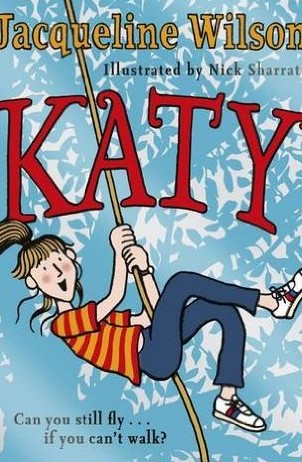Inspiring Young Readers
 posted on 03 Aug 2015
posted on 03 Aug 2015
Katy by Jacqueline Wilson
As is to be expected from this prolific author, this is a great family story full of pace and humour with a range of characters to keep the reader interested. This time, she has adapted and updated What Katy Did by Susan Coolidge, first published in 1872, as an affectionate homage to one of her favourite childhood books and may perhaps lead readers to explore the original. I did this straight after reading and am unsure whether the original would be accessible to many twenty first century young readers with its mannered style and heavy moralistic tone. The Carr children have adventures but they are necessarily bounded by the conventions of late nineteenth century American rural society. Despite this, there are many similarities between the two versions, most obviously in the feisty, brave, imaginative, outspoken central character. In both books Katy is the eldest of six siblings with a kindly father who is a doctor. The children have the same names as those in the original book but Wilson has made this a modern blended family in order to explore these sometimes difficult relationships as she often does in her books. For instance, the two eldest sisters Katy and Clover have experienced the death of their mother at an early age and they now have a stepmother, Izzie (a spinster aunt in the Coolidge version) who is always being compared to an idealised memory. She brings Elsie, her own daughter, to join the family, an unhappy girl who doesn’t fit very well and is heartily disliked by Katy. There are then three younger half siblings: Dorry, Jonnie and Phil who provide Katy with the opportunity to be maternal, wise and often bossy.
The first part of the story is all about winning the reader over to like Katy in terms of her being unconventional and mischievous at home and at school. She is a typically assertive and cheeky Wilson female protagonist who is sometimes thoughtless and self –centred but essentially generous in spirit. She knows that she is being awkward, lazy and unreasonable for much of the time but always manages to make excuses for her behaviour, particularly her consistently obnoxious treatment of her long suffering stepmother. We are also introduced to Dr Helen Spencer, an old patient of Dr Carr who is an adult wheelchair user with rheumatoid arthritis who comes to stay with the family and provides them with a role model of someone who is not held back by her disability. She is independent, attractive and successful with a career as a lecturer at Cambridge University. In What Katy Did, she is merely an invalid cousin who first comes to visit the family on the way to a spa treatment. Helen is supposed to be charismatic, inspirational and life affirming – not a particularly believable character in either book but very necessary to the plot as she foreshadows Katy’s transformation. As in the original story, the reader knows well that pride comes before a fall and in both cases Katy is disobedient once too often and has a terrible physical fall that results in a broken back. The consequences of the accident are dealt with very differently and Wilson’s afterword acknowledges that she has chosen to change the triumph over tragedy aspect of the original story in order to reflect the reality of having a broken back that won’t miraculously get better.
Instead of realising that she should have listened to sensible advice and then learning how to be good as a result of a very long painful convalescence in the bosom of her family, this Katy has a much harder and probably more realistic experience. She spends several dreadful weeks in hospital having been told that she will always be paralysed from the waist down. There she forms a friendship with an older boy who has also been paralysed as the result of an accident and they enjoy being subversive and bitter together for a while. When she returns home, she has to adapt to being dependent on others for a time and to reinvent herself as a wheelchair user. The Coolidge version brings helpful intervention from Cousin Helen who teaches Katy to learn the lessons of Patience, Cheerfulness and Making the Best of Things in what she describes as the School of Pain. Understandably, Wilson has radically rewritten this section and her Helen provides Katy with the encouragement to escape from the confines of her home and begin secondary school. This presents lots of other challenges but she is determined to make a success of re- entering the real world that is sometimes a very cruel place to be. She learns to define her new disabled identity as being active rather than passive as part of a gradual awareness of how to develop resilience and respect which is portrayed well and with sensitivity. Despite this, Katy remains authentically angry, jealous and extremely difficult to live with during this period. However, there is a happy ending as she eventually redeems herself, learns to appreciate her stepmother and becomes more positive about her dramatically changed life.
My main criticism is that this catharsis all seems to happen very quickly so that within a few months she seems satisfied with a pair of red Doc Marten boots and a bespoke red wheelchair as her Christmas presents and has pretty much stopped feeling sorry for herself. On the other hand, this is a story that needs to end on a hopeful note. Jacqueline Wilson has done a very good job keeping the warm and funny essence of the original nineteenth century story. Although her version is thankfully less sentimental, both provide a strong and ever relevant message about the importance of developing self- confidence with the support and care of family, friends and community.
Karen Argent
July 2015